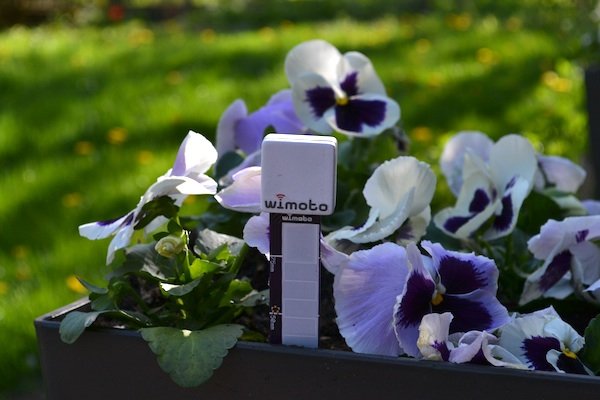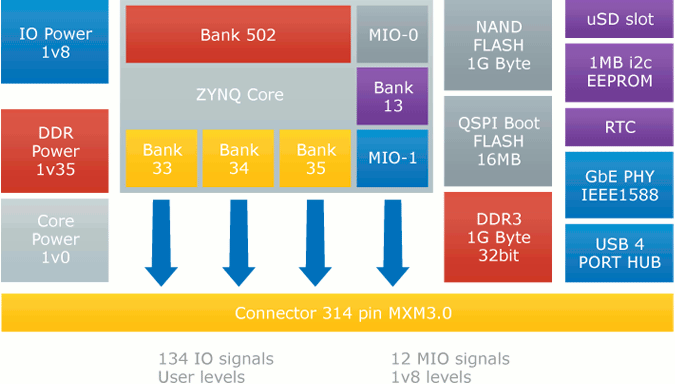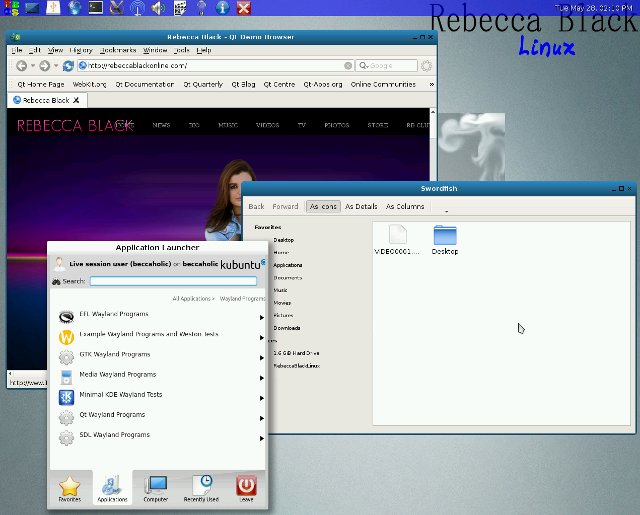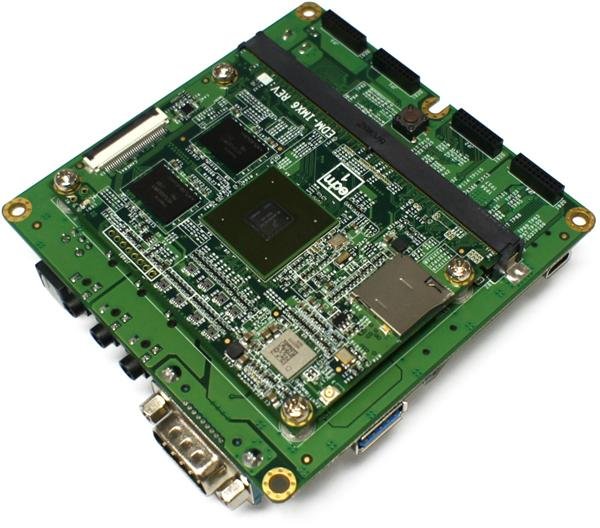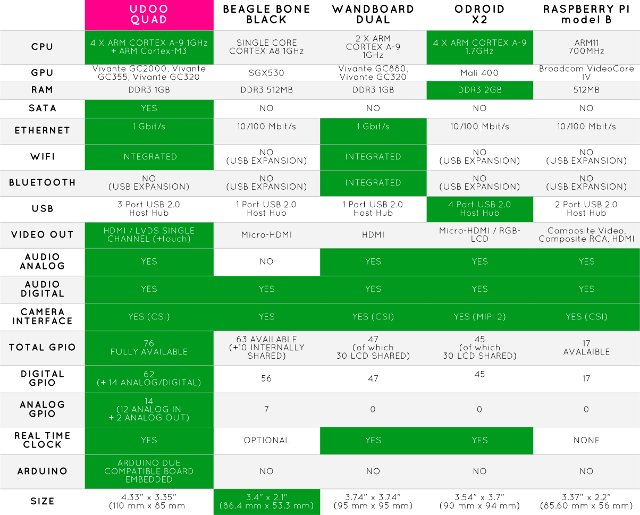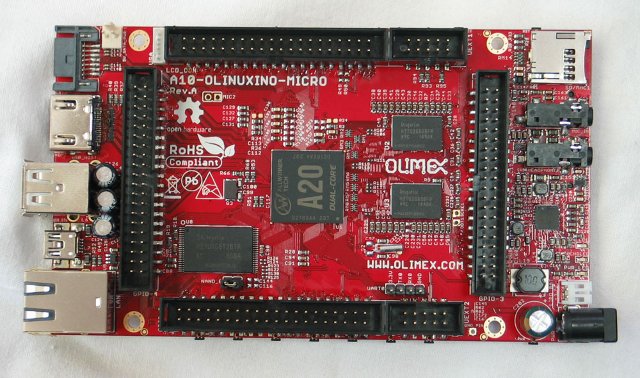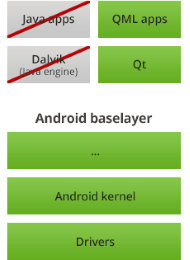Wimoto Motes are small (30x30x8mm) wireless sensors that communicate temperature, humidity, soil moisture… values to your iPhone, iPad, Android, and Linux (yes, including the Raspberry Pi) devices via Bluetooth. They are said to last for about a year on a single CR2032 battery and don’t require an Internet connection to work, but you can still upload your data to Wimoto cloud service via the app, or use an optional mote.cloud bridge to do it for you in realtime via Wifi. There are currently 4 Motes: Climote – Measures light (0 to 60,000 lux), temperature (-25 to 85 C) and humidity. Used to monitor a room environment (bedroom, cellar, greenhouse,…), and tell you if you need to make adjustment Growmote – Measures sunlight (0 to 60,000 lux), soil moisture (5 levels) and temperature (-25 to 85 C), to make sure your lawn or flowers are not thirsty. Thermote – Measures an object temperature […]
EnSilica eSi-ZM1 System-on-Module Features Xilinx Zynq XC7Z020 SoC
EnSilica has introduced the eSi-ZM1 SoM powered by Zynq ZC7Z020 SoC featuring 2 ARM Cortex A9 core, and an Artix-7 FPGA with 85K logic cells. The module also comes with 1GB RAM, 1GB NAND flash, and 16MB QSPI Boot Flash. ZC7Z020 SoC is notably used in ZedBoard development board, so if you have developed an application around this board, and want to commercialize it, using eSi-ZM1 module with your own custom baseboard could be an option. eSi-ZM1 system-on-module specifications: SoC – Xilinx Zynq XC7Z020 dual-core Cortex A9 processor @ 666 MHz, 85 K logic cells, 560 KB block RAM, and 220 DSP Slices. CLG484 package type System Memory – 1 GB, 1.35 V, 32-bit wide DDR3 SDRAM @ 533 MHz Storage: 1 GB, 1.8 V, 8-bit wide NAND FLASH 16 MB QSPI flash 1 or 2 Kb I2C EEPROM (and not 1MB as mentioned in the block diagram ) uSD card […]
RebeccaBlackOS is a Linux Distribution Showcasing Wayland
nerdopolis, a developer and a Rebecca Black fan, has been maintaining a Linux distribution called RebeccaBlackOS that uses Wayland’s reference compositor Weston as the default for handling its graphical user interface, and automatically start “Friday” song as it boots. This distribution actually supports both Wayland and X, as even though QT, GTK, EFL (Enlightenment Foundation Libraries), Clutter, and SDL (Simple DirectMedia Layer) have all been compiled to support Wayland, many apps don’t work with Wayland, so Xwayland provides a way to run many, but not all, X apps in Wayland. You can try the latest 1.8 GB ISO image (24 May 2013), which is based on 32-bit Kubuntu 13.04, by transferring it to a USB flash drive via Unetbootin, or by using the ISO directly in VirtualBox (it will then use the framebuffer). I planned to try it before writing this post, by the “18 hours, 10 minutes remaining” message […]
XBMC Linux Coming to AMLogic AML8726-MX Based Media Players
XBMC now works pretty well on several Android set-top boxes, but if XBMC is the only application you’re going to run on your device, you may prefer running XBMC in Linux to gain a bit in terms of performance. The only catch is that it’s not available yet, but J1nx posted a teaser video showing XBMC running in Geniatech ATV1200 set-top box. The demo above outputs at 720p, hardware video decoding appears to be working, the user interface is rendered at 30fps with a video played in the background, and CPU usage is about 10 to 20%. Under the hood, the box is running Linux 3.0.50, with Linaro 2013.02 armhf rootfs and BusyBox 1.21. An image is not available yet, and there’s no ETA. Jean-Luc Aufranc (CNXSoft)Jean-Luc started CNX Software in 2010 as a part-time endeavor, before quitting his job as a software engineering manager, and starting to write daily […]
$129 Wandboard Quad Board With Freescale i.MX 6Quad and 2GB RAM
When Wandboard launches their Wandboard Solo and Wandboard Dual boards, many people asked when there would be a quad core version. At the time, the company said they had no plan for a quad core version to keep costs low. If we are to believe a Wandboard Quad listing on mouser.com, they must have changed their mind of they now offer a Freescale i.MX6 Quad version with 2GB RAM, and SATA support, which will sell for $129 (as shown on Wandboard site) or $139 (mouser.com) once it becomes available. The Specifications are very similar to Wandboard Dual, except for the quad core processor, 2GB RAM, and working SATA connector: SoC – Freescale i.MX 6Quad quad core Cortex A9 processor @ 1.2 GHz + Vivante GC2000 GPU System Memory – 2GB RAM Storage – 2x micro SD card slot + SATA connector Video Output – HDMI Audio I/O – HDMI, S/PDIF […]
UDOO QUAD vs BeagleBone Black vs Wandboard Dual vs ODROID-X2 vs Raspberry Pi
UDOO QUAD is a development board featuring both Freescale i.MX 6Quad and an Atmel SAM3 Cortex M3 MCU, that’s currently having a very successful campaign on Kickstarter, as the total amount pledged is now close to $500,000 US. UDOO decided to put a comparison table against four other ARM Linux boards they consider their main competitors: the BeagleBone Black for its numerous I/O options, Wandboard Dual, also a Freescale i.MX6 powered board, the ODROID X2 for its powerful Exynos 4412 processor, and Raspberry Pi model B which is ubiquitous. The Cubieboard board would also have been an interesting addition, but they did not include it. As you would have guessed the green parts in the tablet shows the winner for each features according to UDOO team. These 5 boards vary greatly in terms of price, and since this is not included in the table above, I’ll mention the price of […]
Olimex A20-OLinuXino Prototype, AllWinner A20 SoM In The Work
Yesterday, Olimex showed their new A20-OLinuXino board. This AllWinner A20 board is still a prototype, and there are currently 3 of them only, but the good news is that it appears to be working, 50 developer edition boards will be manufactured shortly, and mass production should start in June. AllWinner A20 dual core Cortex A7 can clearly be seen in the middle of the board, but if you look close to the top left, you’ll see a marking: “A10-OLINUXINO-MICRO”. That’s because, as planned, they managed to design one PCB for both AllWinner A10 and A20 processors, and they’ll sell both versions. Olimex A10/A20-Olinuxino boards have the followings specifications: SoC – AllWinner A10 Cortex A8 processor or AllWinner A20 dual core Cortex A7 processor, both running @1Ghz System Memory – 512MB or 1GB DDR3 memory depending on model Storage – 4GB NAND Flash (optional), 2x microSD card slot, and SATA connector […]
Digia Brings Qt to Embedded Android Devices with Boot to Qt
Digia has recently announced Boot to Qt Technology Preview, a commercial offering that provides a solution for the creation of user interfaces on embedded systems. For the first version, they stripped out Android of Java, or other unnecessary parts (Zygote, SurfaceFlinger), added Qt/QML, and tested it on on ARM and x86 hardware. Boot to Qt includes the following main features: A light-weight UI stack for embedded Linux, based on the Qt Framework – Boot to Qt is built on an Android kernel/baselayer and offers an elegant means of developing beautiful and performant embedded devices. Ready-made images – We have images for several different devices which include the Boot to Qt software stack, making it possible to get up and running with minimal effort from day one. Full Qt Creator Integration – One-click deploy and run on hardware and a fully featured development environment. Simulator – A VirtualBox based simulator which allows device development […]


